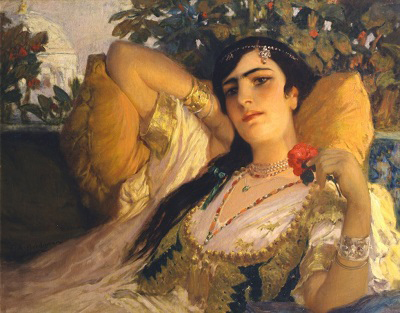Frederic Arthur Bridgman (American, 1847–1928)
An Oriental Beauty
Oil on canvas, 26 x 32 in.
Signed lower left: F. A. Bridgman
2012.16

Bridgman, a renowned late 19th-century American painter, chose to live in France and devote himself to Orientalist subjects—especially North African scenes of daily life. Born in Alabama, he worked as a banknote engraver and trained at the National Academy of Design in New York, before receiving a scholarship in 1866 to study with Jean-Léon Gérôme in Paris at the École des Beaux-Arts. After spending some time in the American artist’s colony in Pont-Aven in Brittany, Bridgman traveled to the Orient in 1872–73, visiting Spain, Morocco, Algeria, Tunisia, and Egypt. He was captivated by the life and light of North Africa and returned many times, especially to Algiers, where he had the rare opportunity to have access to the homes of local people, vividly described in his book Winters in Algiers (1888). Bridgman regularly exhibited his Orientalist subjects at the Paris Salons, the Royal Academy of London, and at private galleries that he rented in Chicago, New York, and Paris. Honored in both America and France, in 1881, he was elected a member of the National Academy in the United States and in 1907 became Officer of the Legion of Honor. He was awarded silver medals at the Expositions Universelles of 1878, 1889, and 1900.
Bridgman’s Oriental Beauty displays his familiarity with the Algerian women he saw and the outfits they wore, as he noted in Winters in Algiers “the height of fashion is to wear everything of the same color, for instance yellow head kerchief bordered with gold and silk fringe, yellow ribbons to ornament the thin chemise, yellow silk bodice, pantaloons of the same color, and yellow leather slipper.” Dressed in color-coordinated and fashionable dress, and adorned with opulent accessories, Bridgman’s beauty languidly reclines in a state of reverie, while her hand gently holds a flower, suggesting she may be dreaming of a lover—an Orientalist trope that catered to 19th-century Western viewers’ expectations.


